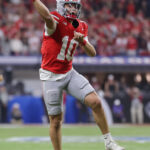ATLANTA — What contributes to the perception that the contest for the National League Most Valuable Player has seemingly reached its conclusion? What underlies the widespread belief that the outcome is already determined? Does this sentiment stem from the prevailing storyline? The prominence of certain star athletes?
It seems a vast majority anticipates Shohei Ohtani securing the NL MVP accolade. The odds, as presented by a well-known source, tell their own story:
Based on these projections, the competition appears to be resolved, rendering further deliberation unnecessary. And, indeed, Ohtani would represent a deserving victor. Given his exceptional capabilities on both sides of the ball, the argument for him being the premier baseball talent globally carries considerable weight.
However, has he genuinely exemplified the utmost value within the National League throughout the 2025 season thus far?
I express some reservation. Actually, I’m inclined to advocate for PCA at this juncture.
Unquestionably, Ohtani stands out as one of the foremost offensive contributors in the league. His previous MVP triumph, earned solely as a designated hitter, attests to his offensive prowess. The rationale behind his current dominance in MVP discussions lies in the assumption that he’s augmenting that offensive impact with his pitching contributions.
Yet, thus far, Ohtani’s pitching appearances have totaled a mere nine innings. While his performance during those innings has been stellar (1.00 ERA, 0.4 WAR), the actual value derived from such limited mound time across 97 Dodgers games remains questionable.
Consequently, we’re essentially evaluating a DH—an exceptional one, undoubtedly the finest in baseball—with an additional nine innings of pitching value. He commands the league in runs scored, home runs, slugging percentage, and OPS.
However, in Ohtani’s tenure as a full-fledged two-way player, the justification for his MVP candidacy centered, appropriately, on his contributions to both offensive production and run prevention. This season, however, the latter is restricted to nine innings of activity.
In contrast, one could contend that Pete Crow-Armstrong emerges as the premier position player in baseball if offensive statistics were disregarded. In other words, focusing solely on baserunning and defensive contributions, he likely leads the pack. His defensive prowess is remarkable, seemingly covering an expansive portion of the Cubs’ outfield and effortlessly tracking down balls in the gaps. Ohtani, notably, does not participate in defensive plays. And while Ohtani achieved the milestone of being a 50-50 player last year, Crow-Armstrong boasts 27 steals this season compared to Ohtani’s 12.
Therefore, let’s assess offensive output. More precisely, does Ohtani possess a sufficiently superior offensive edge over PCA to compensate for the substantial discrepancy in defense/pitching and the moderate difference in baserunning?
Ohtani: .276/.382/.605, 174 OPS+, 12 2B, 7 3B, 32 HR, 60 RBI
PCA: .265/.302/.544, 140 OPS+, 21 2B, 4 3B, 25 HR, 71 RBI
Ohtani undeniably exhibits superior hitting capabilities. That point is beyond dispute. However, does the disparity truly warrant the existing perception? Given PCA’s clear superiority in baserunning and significantly greater value in defensive contributions relative to Ohtani’s nine innings pitched.
Quantifying the collective impact of these factors presents a challenge, but a metric exists. This metric is WAR. While WAR is acknowledged to be a divisive statistic, its value in discerning a player’s relative worth is undeniable. It attempts to distill a player’s total contributions into a single, comprehensive number. Consider the insight it offers when comparing Ohtani and PCA in 2025.
FanGraphs WAR
PCA: 4.9
Ohtani: 4.3
Baseball Reference WAR
PCA: 5.2
Ohtani: 4.3
The divergence in calculations primarily stems from the distinct defensive metrics employed, accounting for the difference in Crow-Armstrong’s figure. Nevertheless, the discrepancies exceed the conventional margin of error.
What definitive conclusion can be drawn? While Ohtani displays superior offensive abilities, PCA excels as an elite defender and baserunner, while maintaining a respectable offensive presence. WAR suggests PCA has been more impactful this season, a sentiment echoed by personal observation. Therefore, what underlies the prevailing consensus of an already-decided outcome?
The matter remains open. It should be regarded as a competition. And presently, I would side with PCA.











